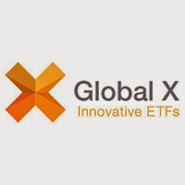By Daniela Pylypczalk-Wasylyszyn, ETF DataBase
Building a traditional buy-and-hold portfolio has become significantly easier and cheaper in recent years, thanks to the Exchange Traded Fund industry’s wide range of options. But while there are hundreds of funds that could be used as a core building block, there is one ETF that stands outs from its peers and should certainly be given a closer look. The
Global X SuperDividend U.S. ETF (DIV) offers investors a lucrative source of steady income, as well as a unique methodology that is designed to withstand periods of market volatility.
Like its name suggests, the SuperDividend U.S. ETF (DIV) aims to provide investors with an attractive stream of current income. It accomplishes this objective by tracking the INDXX SuperDividend U.S. Low Volatility Index, which is designed to measure the performance of companies that rank among the highest dividend yielding equity securities in the U.S.. The index consists of a diverse group of 50 equally-weighted securities, mitigating the risk of a single security having too much influence on the performance of the fund. Sector caps of 25% are also instilled to ensure the portfolio is not heavily overweight in a particular sector.
To be selected for inclusion, a company must meet several requirements, including a minimum market capitalization of $500 million and an average daily trading volume of at least $1 million over the past six months. The stocks must also have paid dividends consistently over the last two years; if a company suspends or cuts dividends, it will be removed from the index at the next quarterly review.
The index also utilizes a low-volatility filter in its screening methodology. Companies must have a beta of less than 0.85 relative to the S&P 500 on the rebalance date.
Under the Hood of DIV
DIV’s portfolio consists of approximately 50 individual securities, none of which have an allocation greater than 3% of the fund’s total assets. DIV features exposure to a diverse group of sectors, though energy, utilities, real estate, and consumer defense equities do receive the highest weightings. The fund also has an attractive mix of market capitalization sizes, which features almost equal exposure to giant, large, mid, small, and micro cap securities.
Considerations on DIV Performance
Given DIV’s focus on equities that exhibit lower volatility relative to the broader market, investors should note that the fund is likely to log in lower returns than riskier equity funds, such as the S&P 500 ETF (SPY). DIV, does however, offer a significantly higher yield than many of its Large Cap Value Equities counterparts, as well as other broad market funds.
How to Use DIV in a Portfolio
The SuperDividend U.S. ETF (DIV) is a great option for investors looking for a solid core holding. Given its focus on both low volatility and yield, as well as its equal-weighted methodology, the fund’s potential will be realized best over a longer time frame.
DIV’s distribution schedule also makes it an attractive addition to any portfolio; the fund distributes its payouts on a monthly basis. With this lucrative payout, investors should consider reinvesting to take advantage of compounding returns.
The Bottom Line
Global X’s SuperDividend ETF (DIV) offers investors an opportunity to receive a steady and attractive stream of income, while at the same time helping mitigate downside risk. The fund’s unique methodology and focus on key long-term fundamentals certainly make it stand out from its peers.
******
Global X SuperDividend (DIV) is a component of the D2 Capital Management Multi-Asset Income Portfolio. Current yield on the portfolio is 4.94% and year to date the portfolio is up 8.33% (as of 5 November 2014).
Disclosure: I own the D2 Capital Management Multi-Asset Income Portfolio
The views expressed here are that of myself or the cited individual or firm and do not constitute a recommendation, solicitation, or offer by myself, D2 Capital Management, LLC or its affiliates to buy or sell any securities, futures, options or other financial instruments or provide any investment advice or service. D2, its clients, and its employees may or may not own any of the securities (or their derivatives) mentioned in this article.














